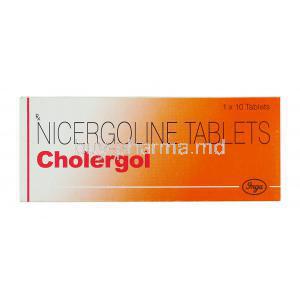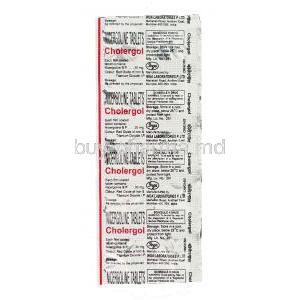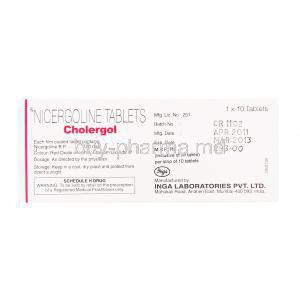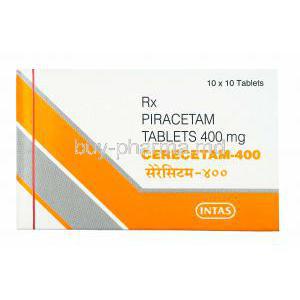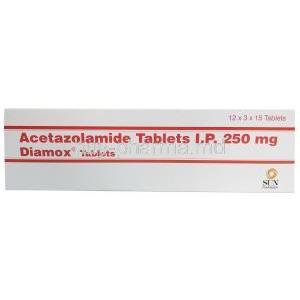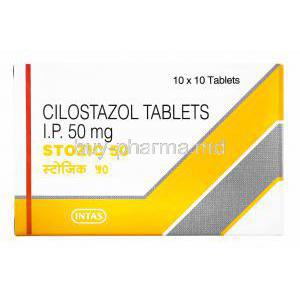Introduction to Cholergol (Nicergoline)
Cholergol, containing Nicergoline as its active pharmaceutical ingredient, belongs to the family of ergot derivatives. It is primarily recognized for its role in enhancing cerebral circulation and improving cognitive performance. As a semi-synthetic derivative of ergot alkaloids, Nicergoline exhibits vasodilatory, neuroprotective, and metabolic-modulating effects within the central nervous system.
Originally developed in the mid-20th century, Cholergol gained clinical importance in managing cerebrovascular insufficiency and age-related cognitive decline. Over time, it has been employed to alleviate symptoms associated with vascular dementia, Alzheimer’s disease, and peripheral circulatory disorders. Today, Nicergoline remains prescribed in several countries for its multifaceted neurological and vascular benefits.
- Brand Names: Cholergol, Sermion, and Nicergoline generics
- Available Forms: Oral tablets, injectable ampoules
- Regulatory Status: Approved in Europe and parts of Asia; prescription-only medicine
Composition and Active Ingredients
The therapeutic efficacy of Cholergol stems from its core compound, Nicergoline. It is an ergoline derivative structurally related to natural ergot alkaloids, but modified to minimize toxicity and enhance cerebrovascular selectivity.
- Active Ingredient: Nicergoline
- Chemical Class: Ergoline alkaloid derivative
- Formulations: 5 mg, 10 mg, and 30 mg tablets; 4 mg/mL injection ampoules
- Excipients: Lactose monohydrate, microcrystalline cellulose, magnesium stearate, and colloidal silicon dioxide
Mechanism of Action: How Cholergol Works
Nicergoline acts as an alpha-adrenergic receptor antagonist, facilitating vasodilation, particularly within cerebral arteries. This increases oxygen and glucose delivery to brain tissues, promoting neuronal metabolism and synaptic activity.
- Improves cerebral blood flow by reducing vascular resistance and enhancing microcirculation.
- Stimulates neurotransmission in cholinergic and dopaminergic pathways, improving cognition and alertness.
- Exerts antioxidant effects by mitigating oxidative stress and protecting neuronal integrity.
- Reduces platelet aggregation to improve vascular fluidity and prevent microthrombosis.
Therapeutic Uses and Indications
Primary Uses
- Treatment of chronic cerebral vascular insufficiency and age-related cognitive impairment
- Adjunctive therapy in vascular dementia and early-stage Alzheimer’s disease
- Improvement of peripheral blood flow in Raynaud’s phenomenon and intermittent claudication
Neurological and Psychiatric Applications
- Management of vascular headaches and migraine prevention
- Relief of tinnitus and vertigo associated with vascular or degenerative causes
Other Approved Indications
- Peripheral arterial disease due to atherosclerosis or diabetes mellitus
Off-Label Uses and Experimental Applications
Emerging studies suggest potential benefits of Nicergoline beyond its approved therapeutic scope:
- Cognitive enhancement in mild cognitive impairment and attention-deficit conditions
- Adjunctive treatment for Alzheimer’s and Parkinson’s disease symptoms
- Supportive therapy in stroke recovery and ischemic brain injury
- Potential use in migraine prophylaxis and chronic vascular headache syndromes
- Improvement of microcirculation and oxygen delivery in geriatric populations
Dosage and Administration Guidelines
- Typical Adult Dose: 10–30 mg orally, two to three times daily
- Route: Oral tablets or intramuscular/intravenous injection (for acute conditions)
- Duration: Determined by clinical response, often over several weeks or months
- With or Without Food: Preferably after meals to reduce gastric discomfort
- Missed Dose: Skip and resume regular schedule; avoid double dosing
Dosage adjustments are essential for individuals with hepatic or renal impairment to prevent accumulation and adverse reactions.
Side Effects of Cholergol (Nicergoline)
Overview of Adverse Reactions
Cholergol is generally well tolerated, but adverse reactions may occur depending on dosage and patient sensitivity.
Common Side Effects
- Dizziness or light-headedness
- Nausea, vomiting, or mild gastrointestinal upset
- Flushing or a sensation of warmth
- Sleep disturbances or mild drowsiness
Serious Side Effects
- Fibrotic reactions (rare, with prolonged high-dose therapy)
- Bradycardia and significant hypotension
- Allergic rash or hypersensitivity manifestations
Long-Term Tolerability and Monitoring
Long-term therapy necessitates periodic clinical evaluations, including blood pressure monitoring, hepatic and renal function tests, and surveillance for fibrotic symptoms.
Drug Interactions
- Antihypertensives: May potentiate hypotensive effects.
- Anticoagulants and antiplatelets: Increased bleeding risk with concurrent use.
- CYP450 inducers or inhibitors: Possible alterations in Nicergoline metabolism.
- Alcohol and nicotine: May diminish cerebral perfusion benefits.
- Dopaminergic/serotonergic agents: Caution due to neurotransmitter overlap.
Warnings and Important Precautions
- Monitor for postural hypotension in elderly or cardiovascular patients.
- Gradual withdrawal is advised to prevent rebound vascular constriction.
- Regular liver and kidney function assessment during extended use.
- Refrain from driving or operating machinery if dizziness occurs.
- Avoid simultaneous use with other ergot alkaloids to prevent toxicity.
Contraindications
- Hypersensitivity to Nicergoline or ergot derivatives
- Acute myocardial infarction or severe bradycardia
- Pregnancy and lactation (due to vasoconstrictive potential)
- History of fibrotic disorders (pulmonary, retroperitoneal, or valvular)
- Severe hypotension or recent cerebrovascular accident
Careful Administration and Monitoring
Cholergol (Nicergoline) requires thoughtful clinical supervision to ensure efficacy while minimizing potential risks. The drug’s vascular and metabolic effects necessitate tailored dosing and continuous observation, particularly in patients with organ impairment or multiple medications.
- Dose Reduction in Hepatic or Renal Impairment: Patients with diminished liver or kidney function may exhibit altered metabolism and elimination of Nicergoline. A lower initial dose, followed by cautious titration, is recommended to prevent accumulation and adverse events.
- Periodic Evaluation of Blood Pressure and Vascular Response: Regular monitoring of systemic and cerebral blood pressure helps detect excessive vasodilation or hypotension. Assessment of vascular responsiveness is crucial during prolonged treatment.
- Monitoring for Fibrosis in Long-Term Use: Extended administration may, in rare cases, induce fibrotic changes in pulmonary or retroperitoneal tissues. Early recognition through imaging or clinical evaluation can avert complications.
- Caution in Polypharmacy: Elderly patients and those with chronic diseases often use multiple drugs. Clinicians should monitor for pharmacodynamic and metabolic interactions that may amplify side effects or diminish therapeutic efficacy.
Administration in Special Populations
Elderly Patients
In geriatric populations, dosage adjustments are necessary to accommodate altered pharmacokinetics and increased sensitivity to hypotensive effects. Starting with the lowest effective dose and gradual escalation minimizes cardiovascular strain. Many elderly patients experience enhanced cognitive function and improved circulation when treated under close supervision.
Pregnant Women and Nursing Mothers
Data on the use of Nicergoline during pregnancy remain limited. Preclinical findings suggest a potential risk of teratogenicity due to its ergot alkaloid structure, and thus it should only be administered when the benefits outweigh the risks. The compound may pass into breast milk, posing potential harm to nursing infants. For this reason, use during breastfeeding is contraindicated, and lactating mothers should seek alternative therapies.
Children and Adolescents
Clinical trials evaluating Nicergoline in pediatric populations are lacking. As a result, the drug is not routinely recommended for children or adolescents. Its safety, optimal dosing, and long-term developmental effects have not been established in this group.
Overdosage and Management
An overdose of Cholergol can result in profound cardiovascular and neurological disturbances. Prompt recognition and intervention are essential for recovery.
- Symptoms of Overdose: Manifestations may include severe hypotension, bradycardia, confusion, nausea, and in extreme cases, syncope or collapse.
- Immediate Supportive Management: Maintain airway patency, ensure adequate hydration, and perform continuous cardiac monitoring. Intravenous fluids help stabilize circulation.
- Use of Vasopressors and Atropine: When clinically justified, vasopressors may restore vascular tone, while atropine can correct symptomatic bradycardia.
- Post-Exposure Observation: Continuous monitoring of vital signs, renal parameters, and electrocardiographic activity is necessary until stabilization is achieved.
Handling and Storage Precautions
Proper handling and storage of Cholergol ensure optimal potency and safety throughout its shelf life.
- Storage Conditions: Keep the medication at controlled room temperature, ideally between 15°C and 25°C. Protect from excessive heat, light, and moisture.
- Shelf Life: Refer to packaging for expiration details. Do not use after the indicated date, as stability may degrade.
- Safe Disposal: Expired or unused tablets and ampoules should be disposed of according to pharmaceutical waste regulations to prevent environmental contamination.
- Handling Instructions: Maintain hygienic conditions when handling ampoules or breaking vials to avoid contamination or accidental exposure.
Summary and Clinical Insights
Cholergol (Nicergoline) remains a valuable pharmacological option for cognitive decline, vascular insufficiency, and other cerebrovascular dysfunctions. Its multifaceted mechanism—enhancing blood flow, modulating neurotransmission, and protecting neuronal integrity—makes it an important adjunct in neurovascular care.
When administered under proper medical supervision, Nicergoline demonstrates a favorable safety and tolerability profile. Ongoing monitoring of blood pressure, hepatic and renal function, and patient-specific response ensures sustained therapeutic success. Individualized dosing, especially in elderly or multi-morbid patients, is vital to balance benefit and risk.
Ultimately, consistent follow-up and cautious titration optimize outcomes, reinforcing Cholergol’s position as a clinically effective agent in the management of chronic cerebrovascular and cognitive disorders.


